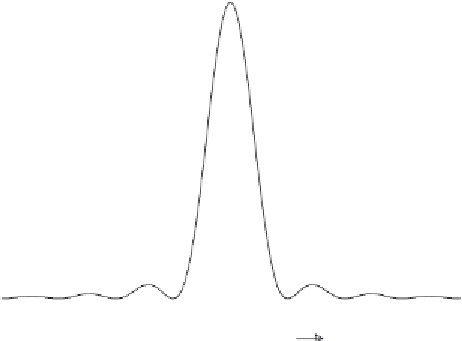Geology Reference
In-Depth Information
T
/2
4/
T
-6/
T
-4/
T
-2/
T
2/
T
6/
T
0
f
Figure 2.9 The Fourier transform of the Bartlett window as a function of
frequency.
window is only 4.5% of the main lobe, instead of 21.2% as is the case for the
frequency window of the boxcar. In addition, the sidelobe heights fall o
inversely
as the square of the distance along the frequency axis from the midpoint of the
window, instead of just inversely as in the case of the boxcar frequency window.
The success of the Bartlett window, in mitigating the frequency mixing that
arises from calculating Fourier transforms from finite records, raises the question
of the possibility of further improvement. We note that the Fourier transform of the
Bartlett window (2.280) can be written as the product of two Fourier transforms,
both of the form
ff
T
2
sinc
π
fT
2
.
(2.282)
T
his i
s the Fourier transform of a boxcar extending over
−
T
/4 <
t
<
T
/4 of height
√
2/
T
. Thus, by (2.269), the Bartlett window is the convolution of two of these
boxcars. Further improvement is indeed possible, by continuing the process, and
taking the convolution of two Bartlett windows to construct the
Parzen window
.
The Parzen window is the co
nvolu
tion of two Bartlett windows, extending over
−
T
/4 <
t
<
T
/4 with height
√
6/
T
. Its Fourier transform is
8
sinc
4
π
fT
3
T
P
(
f
)
=
.
(2.283)
4



Search WWH ::

Custom Search